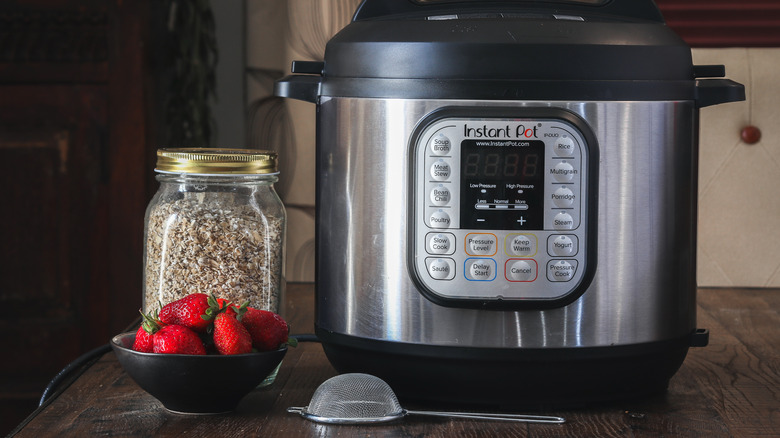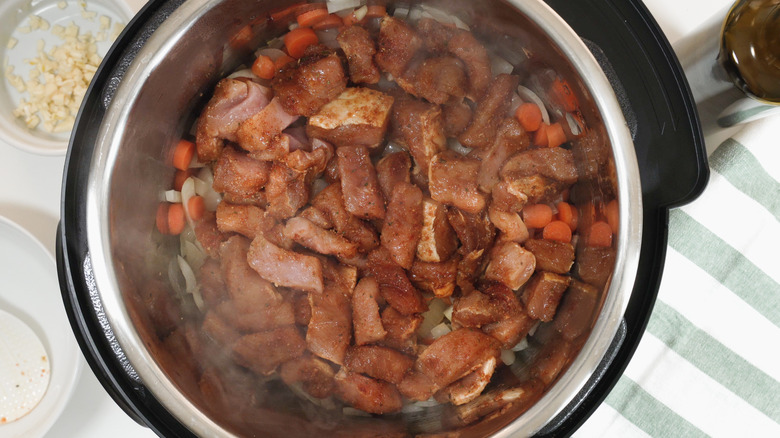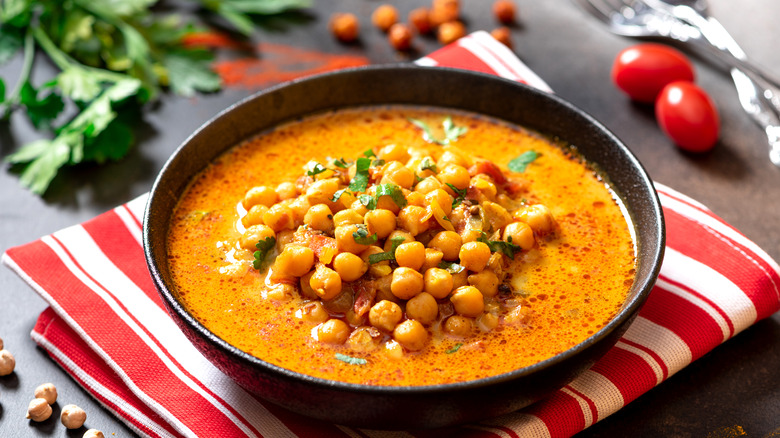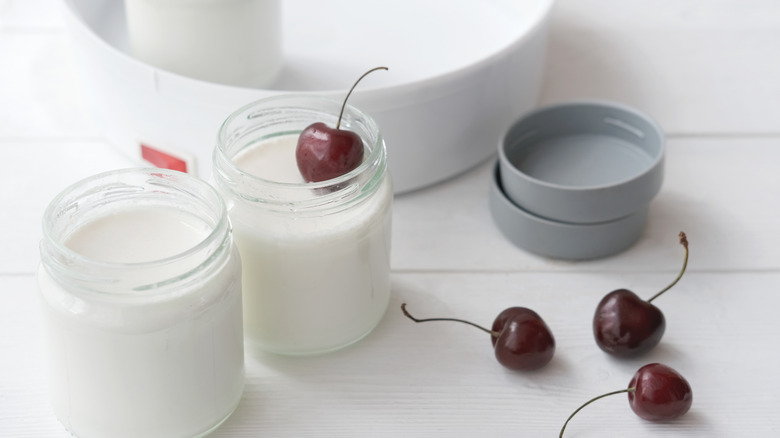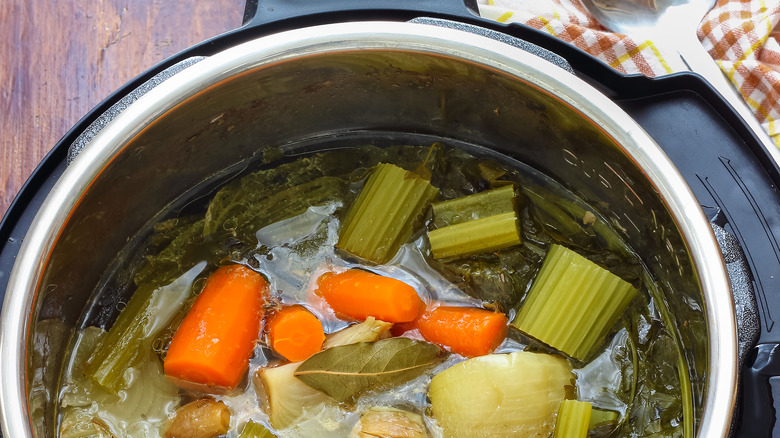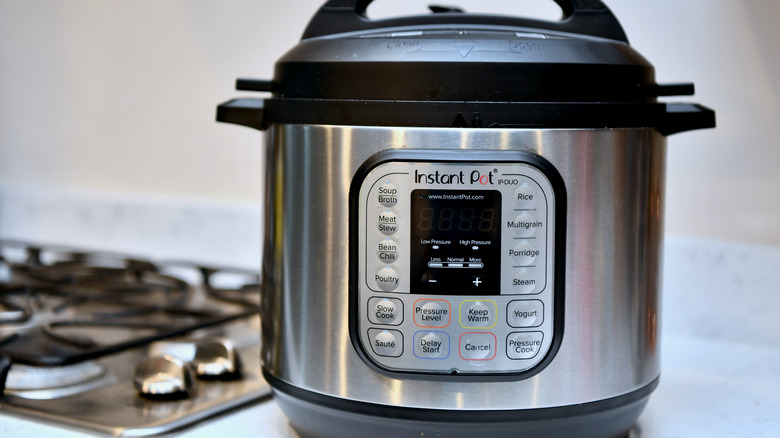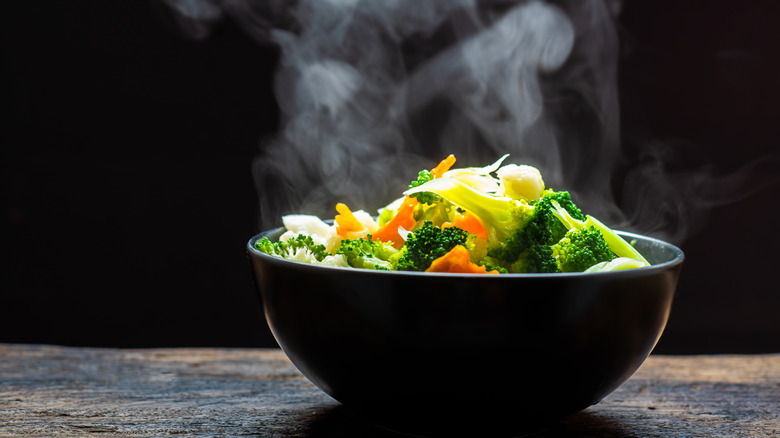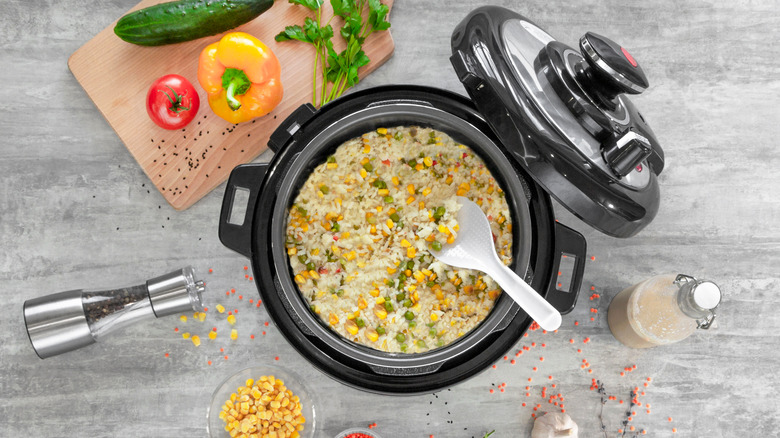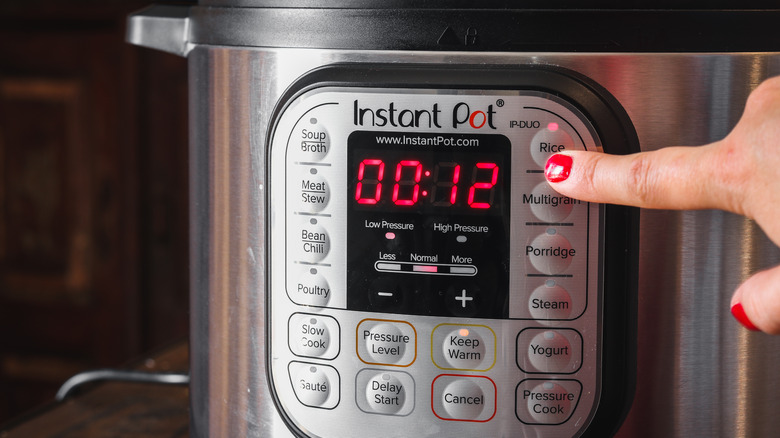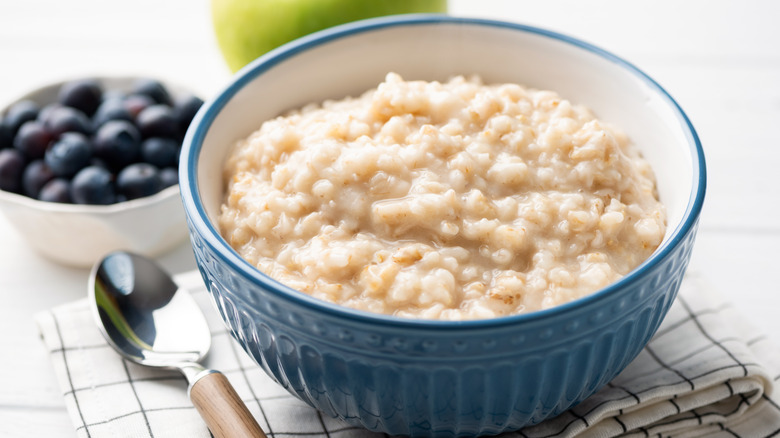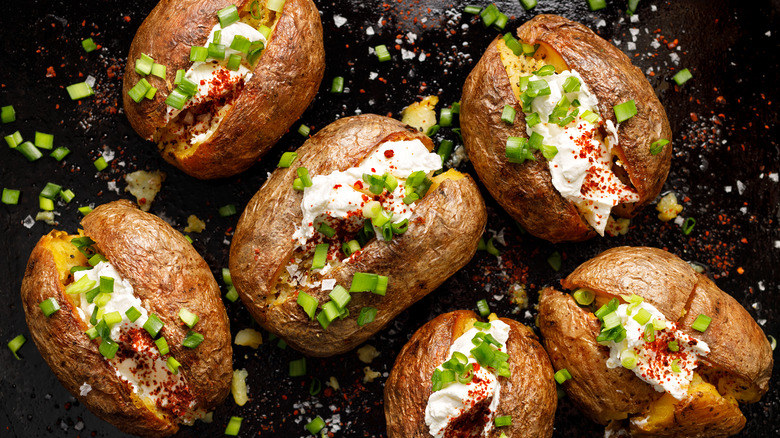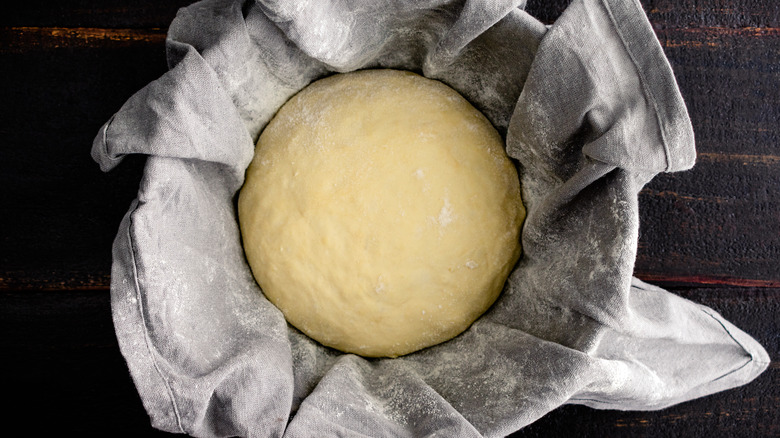The Absolute Best Uses For Your Instant Pot
One of the fortunate things about being a home cook in 2022? There are so many different devices and gadgets out there to help you explore the culinary world. Many of those tools lend themselves to fun and creative experimentation, and there are plenty more that just make getting a meal on the table an easier job. When making a list of essential cooking devices, a few shortlist for the top spot: Immersion blenders, electric pressure cookers, and of course, Instant Pots. Since there are so many nifty appliances, it can be difficult to maximize the best uses for your Instant Pot.
Turning dinner into an effortless affair has been a goal of humanity since long before the 21st century. Fortunately, nowadays, the equipment to do so is better than ever, and we have generations of recipes and ideas to accompany these newfangled contraptions, per Delish. Whether you're a long-time user of the Instant Pot who's stuck in a dinner rut, or you're the lucky new owner of one, there are tons of methods to get the most out of this household necessity. After reading this, you may never want to cook without it.
1. Pressure cooking meals
As Encyclopedia Brittanica has it, the first pressure cookers originated around the late 1600s. The device uses compounded steam to cook foods fast, and as effective as they are, there's no wonder these cookers quickly became ubiquitous in today's kitchens. While there are many makes and models of modern, electric pressure cookers on the market, it's reasonable to say the Instant Pot is the most well-known in the game. It certainly stands up under the heat. In fact, pressure cooking is one of the best ways to use your Instant Pot.
The BBC writes that pressure cookers can cut cooking times by up to 50% for certain meals. In addition to saving you time, pressure cooking also saves nutrients. After all, that was their original intention. So, what sort of things are best cooked under pressure? Start by thinking of the foods you would normally go "low and slow" with and the ones that typically require a lot of attention. Short ribs and beans are a great place to start, and the Instant Pot has also been known to cook up a mean pork shoulder carnitas.
2. Slow cooking chilies or chewy meats
After pressure cooking, the most popular and ordinary use for an Instant Pot is slow cooking. Your first experience with a slow cooker may have come from your grandma's Crock-Pot, but you might be interested to know that this device isn't much older than her generation. The New York Times reports that automatic slow cookers started showing up on the American countertop around 1940. Despite their intended cooking method, this device made a fast rise to become a necessity in today's kitchen. Luckily, the Instant Pot is both a pressure machine and a slow cooker.
The Instant Pot has a special slow cook setting that works perfectly for those long, drawn-out foods such as brisket or lamb shoulder. Ideally, you'll want to use the slow cooking function for any recipes that require a more gentle method. Both (potentially) tough tenderloin and chewy chicken thighs can become mouthwateringly melty when cooked for an extended time at low heat. Additionally, using your Instant Pot's slow cooker setting for chili or stews will give all ingredients a patient path to perfectly paired flavors. Overall, this method is one of the most tried and true usages for an Instant Pot.
3. Making yogurt to cut costs
Slow cooking and pressure cooking are some of the most common and best uses for an Instant Pot, but there are many other unique methods to get the most from this device. One of them is yogurt making. Creating your own, at-home yogurt can serve a lot of benefits. For one, it is less costly than the average store-bought container. Additionally, creating your own yogurt is healthier for the planet and people: Homemade yogurt contains less sugar, and there are no plastic tubs to end up as landfill fodder, per The Guardian.
Making yogurt at home requires careful consideration of temperature. In her reporting for The New York Times, Melissa Clark writes that the Instant Pot is exceptionally good at maintaining the necessary heat. With the yogurt setting, the multicooker will heat your cooking container to the temperature required to kill bacteria, which is around 180 to 200 degrees Fahrenheit. This is a crucial food-safety step. Then, your Instant Pot can maintain the hours-long, 110-degree heat needed to ferment milk into yogurt. Except for adding ingredients, this process is hands-free. Having fresh yogurt on-hand comes with its own culinary benefits. Turn it into flavorful sauces like tzatziki, or freeze it for a delicious custard.
4. ***Create simmering sauces and bone broth
Maintaining a steady temperature isn't only good for yogurt making. It also turns the simmering of sauces and broths into a simple procedure. The Instant Pot is as functional for homemade barbeque as pasta sauce, thanks to a constantly regulated temperature. Pasta has been known to become mushy when made inside a pressure cooker, but using the machine to make homemade marinara will give you the perfect topping for Italian-themed dinners. With store-bought sauces being notoriously full of sugar, crafting your own gives your meals superior flavor and a healthier tilt.
In addition to sauces, The Kitchn writes that the Instant Pot has revolutionized the once intensive process of making nutritious bone broths. By outsourcing a traditionally stove-top process to an electric pressure cooker, the savvy home chef can hack their way to quicker bone broths (and out of a house that smells like the local meat market). Making homemade bone broth can normally take upwards of 24 hours, but by using the Instant Pot, this timeframe is cut to under eight hours. Pressurized cooking keeps the sought-after minerals within your stock, and it also keeps you from having to do much work.
5. Use it for sautéing
One of the most underrated functions of the Instant Pot is its capacity to add an extra burner to your stovetop. Because it heats from the bottom, this device has an incredibly useful function as a sautee pan, per Mashed. When a recipe calls for browning meat, the Instant Pot can be trusted to do the job. With just a touch of oil (or whatever your favorite fat is,) aromatics such as onions, garlic, celery, or shallots can be cooked until sweating, all without having to transfer from stovetop to Instant pot.
Since many Instant Pot meals are a one-pot type deal, this will save you effort in both cooking and cleaning up. There are a few tips for Instant Pot sauteeing. Make sure that you've checked the heat setting. Cooking at too high of a temperature can lead to the same burnt meal as cooking on the stovetop. Also, treat it like a convertible -– leave the roof off, and the ride will be much more enjoyable.
6. Convert it into a steamer
In order to build the necessary force to finish your food, pressure cookers require a certain amount of hot water to be added into the mix. However, you don't need intense pressure to cook your dinner or side dishes. In fact, gentle steaming is one of the most versatile uses the Instant Pot offers.
Pressure might make diamonds, but it doesn't always create high-quality food. Some produce and proteins will actually wilt or even lose their shape when cooked in an Instant Pot. For those circumstances, the "steamer" setting of the device does just fine. Simply fit a steaming basket into the pot's cooking container and go from there. Vegetables with a bit of body, such as broccoli, cauliflower, Brussel sprouts, or carrots, will hold up best. Consider leaving more delicate foods such as arugula or kale to be steamed on the stovetop.
Along with your hearty vegetables, the steaming function is a quick and easy way to make restaurant-style steam buns or dumplings. One thing to be especially careful about is seafood. While dense and fatty salmon may hold up well, CNet suggests that more mild ocean fare like shrimp tend to lose their structure.
7. Use it to make stews or soups
When it comes to making your favorite pot of beef and barley, nothing could be easier than adding the ingredients to your Instant Pot and letting the slow cooker function do its thing. By combining the aforementioned sautee setting with the Instant Pot's ability to keep a constant temperature, you can brown the meat and aromatics for your stew or soup, add the stock and veggies, and then take the day off. As Lifehacker writes, it's as simple as pressing the "Soup" button. The Instant Pot will do the rest, and it'll do it quickly.
As it relates to soup, there is one Instant Pot drawback to mention. The device may be great at making yogurt, but it does not have the same proficiency when crafting other dairy dishes. Reviewers at CNet state that cream-based soups like bisque or chowder will often separate and curdle in an Instant Pot. Unfortunately, the combination of passive pressure cooking can't do it all in this circumstance. Still, many soups don't include dairy, which you can make in a pinch in the Instant Pot.
8. Use it as an over to make soft baked desserts
Despite being ill-equipped to handle creamy soups, the Instant Pot has a secret flex that more than makes up for it. When dinner has wrapped up and your sweet tooth is kicking in, look no further than this multi-cooker for delicious desserts made easy. And yes, some of them even include dairy. (What good dessert doesn't?) Who knew that one of the best uses for an Instant Pot was soft-baked desserts.
Becky Krystal of The Washington Post did. She reports that the key to getting a good dessert from your Instant Pot is to forgo anything that requires a crispy, browned texture. Instead, you'll want to focus on desserts that have a dense and "luscious" texture — the type of desserts that require more steam than intense heat. Under these parameters, Krystal writes that cheesecake, flan, and bread pudding top the list. The Instant Pot recipe book even provides instructions for some of these options. Rice pudding and creme brulee are other reliable dishes in the multi-cooker dessert category but be warned: Kitchen torches are not included, so you'll have to caramelize the top on your own.
9. Treat it as a rice cooker
Speaking of rice, this is another time-consuming food made easier by the Instant Pot. Cooking rice on the stovetop is not necessarily a labor-intensive endeavor, but it can certainly take up a lot of time. Plus, saucepans do have their limits. It can be a task to finish a larger quantity of rice to an even level of doneness. Walk away for a few moments, and you can end up with a burnt bottom despite an uncooked top layer. The Instant Pot takes the guesswork out of making perfectly plumped grains and is especially effective for bigger batches.
One of the best rice-related uses for the Instant Pot goes beyond cooking up an ordinary side item. Turning your weeknight starch into something adventurous can call for a lot of before-hand meal planning, especially when it comes to dishes like risotto. When made from scratch, this Italian favorite demands patience and attention. Boxed risottos are a quick replacement but often have large amounts of sodium and lack fresh vegetables. While the internet is full of recipes for the job, remember these tips from The Kitchn: Use a bit less broth, warm it up before, and save the cheese for post-cooking. Other than that, cooking rice is relatively hands-off.
10. Use it to make easy breakfasts
If the Instant Pot's capacity for making yogurt has got you thinking about breakfast, wait until you hear about what else this machine can put on the menu. For many, breakfast is the most forgettable meal of the day. Rushing to get your coffee, bored of cornflakes — there are loads of reasons for overlooking the first meal. But, no matter how much you ignore or forget it, breakfast remains important to a healthy diet. The easiest way to avoid skipping it is to have quick-serve options on hand. The Instant Pot makes that happen with the touch of a button.
A quick search of the internet will bring up a whole cookbook's worth of recipes for making readily available breakfast options. Some popular and common choices are things like boiled eggs and oatmeal. With the Instant Pot, these foods can be cooked in bulk batches, and each has its own settings. There is a specific button for eggs, but porridges will use the same button as rice. Remember to use rolled, steel-cut oatmeal in the Instant Pot. Other styles of oats will often become textureless blobs. Beyond these popular foods, The Washington Post reports that some creative home cooks have developed recipes for more exciting breakfast dishes. From cinnamon rolls to breakfast burritos, the options are as endless as commuter traffic. At least you'll be well-fed on the ride in.
11. Perfect your potato recipe
Beyond its lactose intolerance, one other category of foods that the Instant Pot struggles with is the crispy kinds. This checks out since the device's main cooking method comes from using hot water. That said, you might be surprised to learn that perfectly cooked potatoes remain one of the Instant Pot's best uses.
If the versatility of the potato never ceases to amaze you, then neither will all the ways you can use an Instant Pot for cooking it. One example is mashed potatoes. With the right combination of water and pressure, you can turn spuds into a fresh batch of mash in half the time that the stovetop requires. Furthermore, this also makes quick-work of starchier varieties like yams and purple sweet potatoes. You'll still need to mix them a bit once the potatoes have cooked, but the full flavor is certainly worth it. Besides mashed potatoes, the Instant Pot can also make soft baked potatoes, per Lifehacker. No more extensive wait times as those russets roast in the oven. As for French fries, well, those are better saved for the air fryer.
12. Create homemade wine or cider
Even with a list full of regular and not-so-regular suggestions for how to best use the Instant Pot, there are still methods that can surprise you. Homemade booze brewing is one of them. Regardless of whether you have a deep interest in distilling your own home wine or you're looking for a fun experiment, your pressure cooker is the unconventional tool you probably didn't consider. The operation is based on a similar fermentation process to making yogurt, requiring specialized yeast and grapefruit juice. As Brian Bennett reported for CNet, you won't end up with anything luxurious, but you will have a vino that's is pridefully palatable.
Along with winemaking, an Instant Pot's pressure and fermentation functions can also be used to make a swiggable cider. Whether or not you choose to spike that is up to you, but the internet has recipes for both family-friendly batches and spiked ones. We're entering into the coldest days of winter, so keep yourself warm in any way you can.
13. Turn it into a popcorn maker
With the East Coast blanketed in icy precipitation and temperatures dropping into the mid-winter aughts, it's good to have snacks on hand for the potential snow day. Even better when the snack involves a bit of to-do for the kids or a low-calorie upside for the diet-focused. As it turns out, an Instant Pot can come in handy here, too.
Popcorn making is an unexpected experience you can create with an Instant Pot, and it's nearly as quick as a microwaved bag, per CNet. Simply click on the sautee setting to low heat, cover the bottom of the pot with oil, add kernels, your favorite seasonings, and suddenly you are your own theatre concession stand. As Healthline has it, the whole grain nature of popcorn means that it can actually contain nutrients when not totally doused in butter, and it also has significantly fewer calories when air-popped. Netflix and chill with your own creatively crafted homemade snack.
14. Use it to make jams, jellies, or preserves
For the most part, if something can be made on the stovetop, it can be made in an Instant Pot. The difference is that choosing the latter often provides cooks with a quicker finish to whatever it is they're making. Jam is one of those cases. Cooking a fresh jam on the burner can take a lot of time, vigilance, and effort. But as PureWow suggests, using the pressure setting on your Instant Pot can churn out a sweet sauce in only a minute.
Further, if you enjoy preparing large batches of jam and then canning them for a later date, then the Instant Pot is not only useful but also essential. Sealing jars for storage requires a specialized process known as steam canning. This procedure seals jars completely, ensuring that no bacteria or air can enter or spoil a product. Typically, steam canning involves a large, specially outfitted pot. Yet, as food blogger Frieda Loves Bread writes, the Instant Pot can replace this contraption. It does require specific instructions and careful usage, but homesteaders and gardeners will find that the Instant Pot is well suited to steam seal not only jams and jellies but homemade pickles and preserves as well.
15. Proof dough in it
Proofing or proving? No matter how you spell it, everyone has a different suggestion for the best place to let your dough rest. Some suggest placing it in the drawer beneath the oven, while others say a well-lit window is the best spot. For the ingenious baker, the Instant Pot does the trick.
It has been mentioned already that the IP isn't a great tool to try and bake with. The setup and function of this multicooker don't lend themselves to baking things at a consistent temperature from top to bottom unless those goods are steamable foods. For this reason, it isn't recommended to try anything more complicated than a quick bread or roll. However, proofing is the one part of the baking process that an Instant Pot can be helpful. Per CNet, for yeasted bread, you'll want to line the Pot with parchment paper and the steaming basket, then use the yogurt setting (or warming setting) and a fully vented valve. Keep an eye on your growing dough ball, as this amazing device can cut the proofing time in half. The Instant Pot may fail at baking thoroughly, but proofing is one of its best uses.
